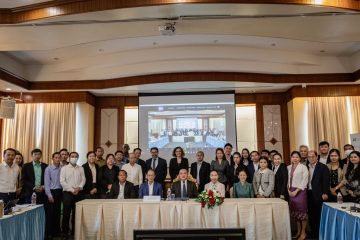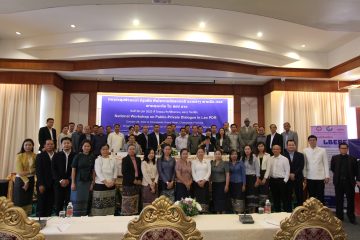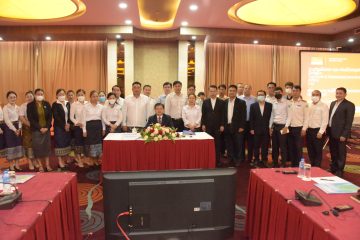Partner Visit to Enhanced Integrated Framework ( EIF) in Oudomxay Province
Oudomxay – 3 October 2022 – The Department of Planning and Cooperation, Ministry of Industry and Commerce (MOIC), in collaboration with Provincial Offices of Industry and Commerce of the three northern project target provinces, Luang Namtha, Oudomxay and Phongsaly provinces, welcomed the visit of development partners and donors to the project field in Oudomxay province.
A part of the visit, a consultation meeting was organized and co-chaired by H.E. Dr. Manothong VONGSAY, the Deputy Minister, Ministry of Industry and Commerce, and Ms. Annette SSEMUWEBA, Deputy Executive Director for the EIF, with total participants of 37 representatives from donors, development partner, MoIC, provincial DoICs and private sector.
In the remarks, H.E.Dr. Manothong VONSAY, Deputy Minister, welcomed all donors and DP and highlighted experiences in making full use of EIF support to promote trade and private sector development, key achievements, challenges, and our future priorities. Particularly on the two DTISs which contributed important steps to the National Integrated Framework Governance Structure (NIFGS). In addition, the Deputy Minister also shared aspects and challenges on how MoIC leveraged AfT governance framework to mobilize support from development partners during the outbreak of COVID-19.
Ms. Annette SSEMUWEBA, Deputy Executive Director for the EIF emphasized achievement of trade development in Laos as the good sample among the 26 LDCs countries. Effective structure and governance of the trade related sector has performed its outstanding outcomes in past years. One of the remarkable observed is single window resource mobilization and governance which still in operation since 2008. Laos has been one of the best practice for project implementation since 2010, through a number of institutional and capacity building. The implementation of projects across EIF Phase 1 and Phase 2 have yielded a host of significant results in strengthening trade mainstreaming and productive capacity related to trade. Lao PDR have demonstrated exemplary Aid for Trade management and coordination through the EIF-established National Implementation Unit (NIU)s, which are strongly embedded in the Ministries of industry and commerce. The objective of the visit is to increase EIF partners’ understanding of the programme’s work in beneficiary countries.
The meeting also touched on the sustainability strategy and modality of project, participation of women and environment impact. The sustainability strategy was planned from the project design phase to assure the continuity of the activities after the project closure. Using strong structure of the local entities and building win-win partnership between firms and producers have provided step forwards to guaranty long term cooperation. Inclusiveness of women from the far reach area helped creation of additional jobs which in turn, producing income and decreasing poverty. The modality has been aware in firms and private sectors in other areas observed from increasing number of attending stakeholders and expected to impact in wider range.
Through the active exchange of experiences of participants, recommendations, lesson learnt and priorities have been raised for consultation as inputs for further AfT programme implementation, especially, implementing agencies through out the project cycle.
In the closing remark, the chairs expressed his great gratitude to all donors, DPs and implementing agencies, and request for further support and cooperation in the trade sector. The chairs also thank for the hard work and commitment of provincial agencies and NIU under the Department of Planning and Cooperation to the project.
ECL Project is funded by the Enhanced Integrated Framework (EIF). EIF is an Aid for Trade partnership in action for the Least Developed Countries (LDCs). Operational since 2009, the EIF is a multi-donor program that supports the LDCs to become more active players in the global trading system by helping them tackle supply-side constraints to trade.


